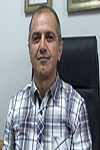Day 3 :
- Dear Euro Biosensors 2016 attendees!
We would like to inform you that 3rd Day of the conference i.e., (July 2nd, 2016) is scheduled for Business to Business Meeting, Networking with Keynotes, speakers, moderator and lunch will be provided from 12:30 -13:30.
We are very much glad to anticipate your presentation at networking and lunch session on 3rd day of the conference.
Thanks and regards,
Edwin Jonson
Euro Biosensors 2016
Session Introduction
James J Lai
University of Washington, USA
Title: Highly sensitive biomarker detection via stimuli-responsive reagents

Biography:
James Lai received his PhD in chemical engineering in 2005 from polytechnic university. He worked as Graduate Research Assistant in Polytechnic University and then he worked as Senior/Post-doctoral fellow in University of Washington during 2005-2009. Currently he is working as Research Assistant Professor in the Department of Bioengineering, University of Washington from 2009.
Abstract:
Clinical diagnostic tests such as immunoassay have been utilized for patient diagnosis to significantly improve health care and reduce costs by detecting trace amounts of certain proteins in patients for identifying harmful cells and troublesome cellular processes. The mainstream immunoassays utilize antibodies immobilized on solid supports for biomarker recognition and separation, which result in long assay time and compromise assay detection limit. In order to achieve higher assay sensitivity, our group has developed stimuli-responsive affinity reagents to address some of the biomarker separation challenges. The reagents such as antibodies conjugated with stimuli-responsive polymers respond sharply and reversibly to physical or chemical stimuli by changing their conformation and physical-chemical properties, i.e. changing from a hydrophilic state to a more hydrophobic state. Stimuli-responsive reagents can replace the antibodies immobilized at solid supports to overcome the mass transport limitations associated with heterogeneous immunoassays because the biomarker binding occurs in a homogeneous solution where molecular diffusion of the reagents facilitates rapid mass transport equilibration. The conjugates can interface with different diagnostic devices to enable rapid immunoassay by facilitating simple and effective biomarkers (or full sandwich immunocomplexes) separation and detection. Additionally, the rapid assay system is scalable to larger starting volumes, which provides opportunities to concentrate dilute biomarkers, thus improving detection ranges and expanding diagnostic options in immunoassays. In this presentation, I will discuss the utilities of stimuli-responsive affinity reagents for microfluidic immunoassay to enable sensitive detection for prostate specific antigen in human plasma as well as rapid biomarker purification and enrichment for infectious disease such as malaria.
Mohamed Serry
The American University in Cairo, Egypt
Title: Graphene-based composite biosensors for continuous glucose monitoring

Biography:
Mohamed Serry is currently an Assistant Professor in the Department of Mechanical Engineering at the American University in Cairo, and leader of the Microfabrication and Advanced Sensor Technologies Research Group. He has completed his PhD from the University of Toronto in 2007, and MSc from the University of Albertain 2003. His research is focused on microfabrication technology and the design and implementation of a wide range of novel sensors based on the integration of advanced nanomaterials on microsystems. He has published more than 35 technical papers in international journals and conferences and holds three granted/pending US patents.
Abstract:
Diabetic complications, especially cardiovascular disease and renal disease, make diabetes the seventh leading cause of death in the USA in 2007. Close monitoring and timely correction of elevated blood sugar can reduce the risk of diabetes-related complications. Portable glucometers, which measure blood glucose levels by finger pricks, may fail to detect rapid glucose changes. Continuous Glucose Monitoring (CGM) sensors using electrochemical detection are intended to address this, however, enzyme-catalyzed CGM have significant drawbacks, including (1) detection errors from irreversible consumption of glucose of the tissue, (2) drift over time, due to H2O2 production as a byproduct, affecting device accuracy, reliability, and longevity, and requiring repeated calibration (2-5 times/day), (3) need for frequent replacement (every 3-5 days), due to H2O2, and O2 mediators, (4) intermediate reactions that delay detection with possible false signals, due to interference with ascorbic and uric acids. Therefore, there is a dire need for non-enzymatic, mediator-free electrochemical glucose detectors which provide rapid response, better stability, and allow full implantation and wireless detection. In this work, we introduce non-enzymatic, mediator free glucose sensors by growing CVD graphene on a nanostructured platinum/silicon Schottky junction. Non-enzymatic detection is achieved by the adsorption of glucose molecules on the graphene surface, glucose OH− groups interact with O2 on the graphene surface. This interaction p-dopes the graphene layer, shifting the Dirac point to positive potential, thus varying the Schottky barrier’s height (SBH) and width, resulting in a detectable current change. The results indicated that the proposed sensor provided a highly sensitive, more facile method with good reproducibility for continuous glucose detection.
Mahmoud Almasri
University of Missouri, USA
Title: An impedance biosensor for accurate and rapid detection of foodborne

Biography:
Mahmoud Almasri received PhD in Electrical Engineering from Southern Methodist University Dallas, TX, 2001. He is currently an Associate Professor with the Department of Electrical and Computer Engineering, University of Missouri. He was with General Monitors, CA as a research scientist. Then, he was with Albany nanotech, NY as a post doctoral research associate, and he was with Georgia Institute of Technology as a post doctoral fellow. His current researchers include biosensors, MEMS power harvester, IR material and detectors, MEMS Coulter counter. His research is mainly funded by NSF, ARO, LWI, and USDA. He is senior IEEE member.
Abstract:
An impedance biosensor for rapid detection of low concentration Escherichia coli O157:H7 was designed, fabricated and tested. The biosensor has the following innovative features: (1) a focusing region consisting of ramped down vertical (electroplated) gold electrode pair made along with 45o tilted thin film finger pairs. This configuration generates p-DEP force to concentrate the bacteria into the center of the microchannel, and direct them toward the sensing microchannel which has a diameter smaller than one-third of the first channel. The bulk fluid flows into the outer channel towards the waste outlets. (2) Bacteria sensing region consists of three interdigitated electrode arrays (IDEA) with varying number of fingers (30, 20 and 10 pairs respectively) coated with anti-E.coli antibody. As E.coli reaches the sensing region it binds to the antibody on IDEA surface, and results in impedance change. This has enabled detection of a very low concentration of bacteria with a very high sensitivity and rapidly. Fabrication of the biosensor was performed on a glass substrate using SU8 negative photoresist to form the microchannel, gold electroplating to form the vertical focusing electrode pair, thin gold film to form the detection electrode, the finger electrodes, traces and bonding pads, and PDMS to seal the device. Various low concentration E.coli samples were tested to determine the sensitivity of the biosensor and the lowest detection limit of the biosensor was found to be 14 CFU/ml. The total turnaround time, from antibody immobilization to pathogen detection was about 2 hours.

Biography:
Erping Long has completed his bachelor degree of clinical medicine from Sun Yat-sen University and now is having postgraduated study in Zhongshan Ophthalmic Center. He is the reviewer of the journals “Scientific Reports†and “PLoS Oneâ€. He has published 9 papers, including reputed journals Science (IF 33.611), Scientific Reports (IF 5.578), Parasites & Vectors (IF 3.44), PloS One (IF 3.234).
Abstract:
Background: Schistosomiasis japonicum remains a considerable economic and public health concern in China, the Philippines and Indonesia. Currently available measures to control the unique intermediate host Oncomelania hupensis are frequently associated with severe side effects. Previous studies have demonstrated that linalool-rich extracts from various plants exhibited promising biological activities including cytotoxic, anti-microbial and anti-parasitic properties. Methods: We identified the components of leaf extracts from Cinnamomum camphora by gas chromatography coupled to mass spectrometry (GC-MS) and investigated molluscicidal and larvicidal effects of linalool against O. hupensis and Schistosoma japonicium. The ultrastructural alterations in gills, salivary gland, stomach and hepatopancreas of snails were observed under the light microscope and transmission electron microscope, and lesions to tegument of cercaria were examined under a light microscope and fluorescence microscope. We then evaluated the effects of linalool on skin penetration and migration of schistosomula and adult survival by measurement of worm burden and egg counts in Balb/C mice infected with linalool-treated cercariae. Results: In the present work, 44 components were identified from the leaf extracts of C. camphora, of which linalool was the most abundant constituent. Linalool exhibited the striking molluscicidal and larvicidal effects with LC50 = 0.25 mg/L for O. hupensis and LC50 = 0.07 mg/L for cercaria of S. japonicium. After exposure to linalool, damage to the gills and hepatopancreas of the snails, and to the tegument and body-tail joint of cercariae was apparent. In addition, linalool markedly reduced the recovered schistosomulum from mouse skin after challenge infection, and therefore decreased the worm burden in infected animals, but not fecundity of female adults of the parasite. Conclusions: Our findings indicated that linalool might be a novel chemotherapeutic agent against S. japonicium and the snail intermediate host.
Serban F Peteu
Michigan State University, USA
Title: Peroxynitrite detection: Recent innovations and remaining challenges

Biography:
Serban F Peteu serves as Professor Adjunct in Chemical Engineering & Materials Science at Michigan State University in USA. He did his Post-doctoral studies at the University of Michigan in 1996 sponsored by a Fulbright Award, after earning his PhD in Biotechnology-Bioengineering from Bucharest Polytechnic in 1992. He published over 50 papers and patents and was elected in 2005 as Editorial Board Member for the Elsevier Journal “Biosensors Bioelectronicsâ€. His work in peroxynitrite detection started in 2010 and continues to date. He co-edited the first book focused on peroxynitrite detection, just published by the Royal Society of Chemistry.
Abstract:
The most harmful of the reactive nitrogen and oxygen species in vivo is peroxynitrite (ONOO—), the reaction product of nitric oxide and superoxide. When present in excess, peroxynitrite is known to disturb the physiological balance in organisms leading to the nitro-oxidative stress. Its extended action over time through nitro-oxidative reactions in vivo is clinically correlated with chronic degenerative diseases, such as: cardiac (myocarditis; graft rejection; heart failure), vascular (atherosclerosis; aging; hypertension); neurodegenerative (Parkinson’s; Alzheimer’s; multiple sclerosis); diabetes and complications (neuropathy; nephropathy; retinopathy) and inflammation (chronic; toxic origin; arthritis). The ability of biosensors for rapid and real-time analysis in a multi-analyte format at relatively low cost will allow the quantitative and qualitative detection of ONOO—. The peroxynitrite sensitive and selective sensors and probes will facilitate a screening-type analysis and potentially prevent these numerous diseases. Consequently, many efforts are underway to detect peroxynitrite in biological media. This invited review will critically discuss for the first time the very latest innovations in the field of peroxynitrite biosensors and probes for in vivo and in vitro studies with the remaining challenges. Thus, the main trends will be extracted, in order to chart the future directions and hence create an instrumental outlook.

Biography:
Kavita Garg has completed her Masters from Delhi University and PhD from Homi Bhabha National Institute, Bhabha Atomic Research Centre; Mumbai. Currently she is working as a Young Scientist at Indian Institute of Science, Bangalore. She is working in the area of organic electronics from past 7 years. She has published her work in more than 12 reputed journals and conference proceedings.
Abstract:
Porphyrins are highly conjugated, intense colored and the core of key biomolecules “hemoglobin and chlorophyllâ€. Biological systems use porphyrins and metalloporphyrins as catalysts, small molecule transporters, electrical conduits and energy transducers in photosynthesis, hence are an obvious class of molecules to investigate for molecular electronic functions. As a class of molecule, they are robust; possess distinctive reversible oxidation and reduction chemistry. As synthetic porphyrin chemistry is well developed and molecular orbital models accurately predict the electronic consequences of appending organic substituents and binding metal ions. Electronic properties of porphyrins can be tuned by chelation of a metal ion and substitution on the macrocycle that potentiates their use as wires, switches, transistors, junctions, and photodiodes. There are two notable early examples of supramolecular devices based on porphyrins, one as photo-gated ion conductors and another as memory device. Here, we have demonstrated molecular resonance tunneling diode and molecular rectifier based on porphyrin molecules. Resonance tunneling diode is constructed on a σ−π−σ molecular architecture, with a ‘quantum well (a Ï€ conjugated molecule “Porphyrinâ€)’ surrounded by tunnel barriers (σ alkyl chains), electro-grafted on H-terminated Si. These devices exhibited reversible, stable (up to 8 h of voltage scanning) and room temperature NDR (Negative Differential Resistance) effects. Molecular rectifier with donor-spacer-acceptor (D-s-A) structure, electro-grafted on H-terminated Si behaves as a diode. These devices showed RR (Rectification Ratio) up to 107 in reverse bias as a result of alignment of the LUMO levels of the molecules with the Fermi-levels of the electrodes.
Naumih Noah
United States International University Africa, Kenya
Title: Nano-based biosensor for detection of bilharzia

Biography:
Naumih Noah has a PhD in Analytical Bioanalytical Chemistry from the State University of New York at Binghamton. She is currently an Assistant Professor at the School of Pharmacy and Health Sciences in United States International University Africa located in Nairobi, Kenya. She has authored more than 10 papers in peer reviewed journals most of them on biosensors.
Abstract:
Bilharzia is one of the neglected tropical diseases (NTDs), a group of chronic disabling infections affecting more than a billion people worldwide, mainly in Africa and mostly the poor. In Kenya, these NTDs affects more than 50% of the population fueling the vicious circle of poverty and stigma that leaves people unable to work, go to school, or participate in family and community life. Highly sensitive detection and accurate analysis is essential for the early detection, treatment, and management of these diseases. Current methods of detection rely on microscopic detection which is tedious, unreliable and suffers poor sensitivity. In this work, a nano-based immunosensor for early detection which rely on nano-immunological response between antibodies against bilharzia conjugated to nanoparticles and bilharzia antigen will be reported. The conjugation of the antibodies with nanoparticles combines the unique properties of the nanoparticles with the specific and selective recognition ability of the antibodies to antigens. The hybrid product has improved cellular uptake as well as the major intracellular stability and may show versatility and specificity with improved analytical signal important for rapid, sensitive and real-time point of care diagnosis. The work will report the use of screen printed electrodes for a potential development of a nano-device for point-of-care diagnostic of bilharzia.
Rostyslav Bilyy
Danylo Halysky Lviv National Medical University, Ukraine
Title: Targeting glycocalyx of dying and pathological cells

Biography:
Rostyslav Bilyy, PhD, DrSci, heads the Immunology Laboratory of Danylo Halytky Lviv National Medical University and is a senior researcher of Institute of Cell Biology NAS of Ukraine. In 2007, he defended his PhD study on Cell Biology, Cytology and Histology devoted to alteration of cell plasma membrane at apoptosis. In 2012, he was honored a Docent degree from the Danylo Halytky Lviv National Medical University, and in 2015 he was awarded Habilitation in Cell Biology, Cytology and Histology. His major scientific discoveries include the establishing of mechanism underlying plasma membrane glycan modification at cell death, deciphering the pathways of apoptotic blebs formation with altered glycosylation.
Abstract:
Every eukaryotic cell is covered with a complex ensemble of glycans attached to both proteins and lipids of plasma membrane altogether comprising cell glycocalyx. Our recent studied demonstrated that cell death is accompanied with dramatical changes in glycocalyx content. One can target these changes for detection of dying cells & modulating immune response against them; moreover, some pathogens also utilize changes in cell glycocalx to penetrate host cells and colonize them. Apoptotic cells produce of two types of apoptotic cell-derived membranous vesicles (ACMV) (Bilyy, JBC, 2012), each bearing distinct glycosylation patterns, and they posses distinct role in the immune response and host-pathogen interactions. Formation of 2 types of ACMV are related to two active pathways of modification of glycocalyx in dying cells: a) caspase-dependent activation of plasma membrane-assosiated neuraminidases leads to the formation of desialylated glycoepitopes on ACMV originating from plasma membrane (PM); b) with the aim to compensate membrane surface loss due to apoptotic blebbing dying cells expose on their surface immature membranes of endoplasmic reticulum (ER), bearing a moiety of oligomannosidic glycans. PM-derived ACMV are usually big (>3µm) and contain nuclear material (histone and DNA), which actively translocates into the ACMV at the late stages of formation. ER-derived ACMV possess oligomannnosidic glycans, attributable to ER, that represent immunologically novel epitopes rapidly cleared by macrophages. Exposure of ACMV-contained nuclear material may support the formation of anti-nuclear (anti-histone and anti-DNA) antibodies in disorders, associated with impaired clearance, like SLE. At the same time adherent-invasive Escherichia coli (AIEC) cells, causing uropthatogenic infections and Crohn’s disease, are known to utilize oligomannose-specific lectin FimH at the tip of their fimbriae to adhere to the host cells. Interaction of AIEC with host cells induces formation of ER-derived ACMV by the latter and fosters bacterial attachment to host cells and their colonization.
Lucian Baia
Babes-Bolyai University, Romania
Title: Highly porous based nanocomposites designed for ultrasensitive detection of environmental pollutants

Biography:
Lucian Baia earned his PhD degree in 2003 at the University of Würzburg, Germany. Since 2008, he works as Associate Professor at the Department of Condensed Matter Physics and Advanced Technologies at the Faculty of Physics of the Babes-Bolyai University. His current research focuses on the obtaining and characterization of porous and highly porous nanoarchitectures with controllable morphology and structure for environmental and biomedical applications. He is author or coauthor of more than 100 peer-reviewed publications (h-index: 19), three books, and three book chapters, 3 patent applications and is serving as Editorial Board Member for several scientific journals.
Abstract:
Aerogels are highly porous materials with a low density, large open pores, and a high inner surface area produced via sol-gel process followed by supercritical drying. Their unique morphological characteristics like pore volume, pore size distribution and connectivity, make them suitable for sensor applications. Our research activity in the last period was focused on designing such uniqe porous structures for improving their capability for ultrasensitive detection of environmental pollutants. In this respect, the first approach consisted in designing TiO2 aerogel-Au/Ag nanoparticles based materials for efficient detection by using Surface-Enhanced Raman Scattering (SERS), taking into consideration the great enhancement of the Raman signal that occurs after positioning a pollutant molecule on Au/Ag nanoscale-roughed surfaces, or in their proximity. The greatest performances related to the mentioned functionalities were acquired for the porous composites obtained by impregnating the titania gel with Au/Ag nanoparticles followed by supercritical drying, and the lowest detectable concentrations by SERS varied between 10-2 and 10-10 M, depending on the synthesis method, pollutant species and the excitation type, i.e. off and under resonant condition. The second approach is related to the obtaining of electrodes based on Bi doped carbon aerogels and xerogels, incorporated in a matrix of chitosan, and deposited on glassy carbon, for the ultrasensitive voltammetric detection of heavy metals like Pb(II) and Cd(II), and pharmaceuticals compounds. For this approach the detection limits were found to be between 10-8 and 10-13 M, depending on the pollutant type.
Vinod Kumar Gupta
Indian Institute of Technology Roorkee, India
Title: New molecular imprinted voltammetric sensor for sensitive determination of ochratoxin A

Biography:
Vinod Kumar Gupta had obtained his PhD in Chemistry from the University of Roorkee (now Indian Institute of Technology Roorkee) Roorkee, India, in 1979. Since then, he is pursuing research at the same Institute and presently holding the position of Professor, Chemistry Department, at Indian Institute of technology Roorkee, Roorkee. He worked as a Post-doctoral fellow at University of Regensburg, Germany, in 1993 as an EC fellow and was DAAD visiting Professor at University of Chemnitz and Freie University of Berlin in 2002. He has published more than 500 research papers, many reviews and 4 books which fetched him more than 36,000 citations with h-index of 125. He was awarded the Indian Citation Laureate Award in 2004. His research interests include chemical sensors, waste water treatment, environmental and electro analytical chemistry. He has been an elected Fellow of the World Innovation Foundation (FIWF) since July 2004 and Fellow of the National Academy of Sciences (FNASc) since 2008.
Abstract:
In this report, a novel molecular imprinted voltammetric sensor based on silver nanoparticles (AgNPs) involved in a polyoxometalate (H3PW12O40, POM) functionalized reduced graphene oxide (rGO) modified glassy carbon electrode (GCE) was presented for determination of ochratoxin A (OCH). The developed surfaces were characterized using scanning electron microscope (SEM), transmission electron microscope (TEM), x-ray photoelectron spectroscopy (XPS) and x-ray diffraction (XRD) method. OCH imprinted GCE was prepared via electropolymerization process of 100 mM phenol as monomer in the presence of phosphate buffer solution (pH 6.0) containing 25 mM OCH. The linearity range and the detection limit of the method were calculated as 5.0×10-11-1.5×10-9 M and 1.6×10-11 M, respectively. The voltammetric sensor was applied to grape juice and wine samples with good selectivity and recovery. The stability of the voltammetric sensor was also reported.
Bhanu Neupane
Kathmandu Institute of Applied Sciences, Nepal
Title: Design of stimulated emission depletion microscope and applications on cell imaging

Biography:
Bhanu Neupane has completed his from Kansas State University, Kansas, USA and Postdoctoral studies from Biomedical Engineering Department, a joint Department of University of North Carolina and North Carolina State University, North Carolina, USA. He is Research Scientist in Kathmandu Institute of Applied Sciences, Kathmandu, Nepal. He has published more than 15 papers in reputed journals like Journal of American Chemical Society, Nano Letter, Nanoscale, Chemical Reveiws, Sensors, etc.
Abstract:
Stimulated Emission Depletion (STED) microscopy is a powerful optical imaging tool that provides diffraction unlimited resolution down to few tenth of nanometers in cell and tissue samples. STED microscope can be built in different versions. In this paper, detail design of continuous wave STED microscope will be discussed. Such microscope shows excellent performance in resolving self assembly patterns of polymeric nanoparticles at various ionic strength conditions. The application of this microscope in resolving nanoscopic cytoskeleton protein structures in both fixed and live cells will be presented. Other potential applications of such microscope in cellular and tissue imaging will be discussed.
Giampaolo Zuccheri
University of Bologna, Italy
Title: Molecular self-assembly for signal enhancement in nucleic acids biosensors

Biography:
Some of the possible perspective advantages of the uptake of nucleic acids biosensor technology are already within reach, still, sometimes, limited sensitivity can seriously inhibit the application of biosensor-based detection methods when these could be useful towards detection of nucleic acids variants present only at a very low concentration. While in a research lab, this objective is achieved using complex but sensitive amplification techniques, such as PCR, or the deployment of sophisticated sensitive detection techniques, this goal might prove a prohibitive objective for point-of-need biosensors. Recently, through knowledge and capabilities developed within the field of DNA nanotechnology, means to implement very specific molecular recognition and signal enhancement methods have been presented that could prove of direct application for biosensor detection methods. We have adapted and attempted at using the hybridization chain reaction (HCR) towards enhancing the signal due to the specific recognition and binding of soluble nucleic acids to a surface-bound probe. The enhancement strategy consists in a triggered supramolecular polymerization of DNA sequences or nanostructures at the location of specific nucleic acids recognition. We have showed that the method can be used towards the detection of an arbitrary DNA target through proper design of the sequences of the components. Preliminary experimental evidence shows a significant enhancement of the signal, which could prove useful in some applications. We also proved that HCR can have single-nucleotide sensitivity for the detection and signal enhancement. We recently extended the application of HCR towards the detection of miRNA targets. This strategy is compatible with several detection techniques that can be implemented on a lab-on-chip, such as electrochemistry or surface plasmon resonance, while it can also be measured via fluorescence and luminescence, achieving higher detection sensitivity.
Abstract:
Giampaolo Zuccheri received his PhD in Chemistry from the University of Calabria, Italy, in 1998 and his degree in Industrial Chemistry cum laude from the University of Bologna, Italy. He has worked as a Research Assistant at the Lawrence Berkeley National Laboratory (Berkeley, CA, U.S.A.) and at the Institute of Molecular Biology of the University of Oregon (USA). He holds a permanent faculty position at the University of Bologna (Italy) since 2002 where he now directs the Nanobiotechnology Laboratory of the Department of Pharmacy and Biotechnologies. He is coauthor of 45 papers in international peer reviewed journals and editor of two books.

Biography:
dfvg
Abstract:
Chronic diseases are becoming more prevalent, and the complexities of managing patients continue to escalate since their care must be balanced between the home and the clinical settings. Diabetes is the most advanced example where self-monitoring has been shown to be necessary. Glucometers are point-of-care (POC) devices that have become standard at home and clinical settings. Similarly, many other POC biosensors have also been developed. Enzymes are often used in these sensors because of their specificity and the reaction products can be electrochemically transduced for the measurement. When enzymes are immobilized to an electronically active substrate, the enzymatic reactions can be transduced by direct electron transport. This paper describes an approach for the development of graphene-based POC devices. This includes modifying enzymes for improved performance, developing methods to bind them to the graphene surface, incorporation of the functionalized graphene on a field-effect transistor (FET), and integration into a microfluidic device suitable for home use. This paper describes an approach for the development of a graphene-based POC biosensor platform using glucose as an example of target molecule.
Alok Prasad Das
Siksha ‘O’ Anusandhan University, India
Title: Indigenous biodensor for rapid and low cost endotoxin detection system

Biography:
Alok Prasad Das has completed his PhD from CSIR-Institute of Minerals and Materials Technology. He is presently working as Assistant Professor and Project Lead at Bioengineering Laboratory, Centre of Biotechnology, Siksha ‘O’ Anusandhan University, Bhubaneswar, Odisha, India. He has published more than 50 papers in reputed international and national journals, book chapter and conference proceeding and has been serving as an Editorial Board Member of reputed journals.
Abstract:
Endotoxin is a signature molecule of gram-negative bacteria and is clinically significant as the agent of gram-negative sepsis, a disease condition with high mortality. Bacterial endotoxin infection induces multiple adverse biological effects including fever, sepsis, systemic organ failure, platelet aggregation and thrombocytopenia. This study describes an enzyme-substrate reaction using the distilled water lysate of the granular hemocytes (amebocytes) of the mangrove horseshoe crab (Tachypleus gigas), a native of the Bay of Bengal, and a chromogenic peptide which results in the production of yellow spectroscopically monitored product in the presence of endotoxin. The assay is complete within 30 minutes and shows a lower detection limit of 0.02 EU/mL. The novelty of our approach is the use of mangrove horseshoe crabs as the source of amebocyte lysate instead of the American horseshoe crab (Limulus polyphemus). The anticipated methodology offers advantages for the South Asian market that include a low cost due to use of indigenous reagents. This method shows exquisite sensitivity and provides a rapid assessment of LPS concentrations. We believe that the marketable advance of our methodology will reduce the cost of present endotoxin detection test as compared to the cost of present imported kits presently available in Asian and Indian market.
Liuz Pereira
University of Aveiro, Portugal
Title: Odor biosensors based on organic semiconductors towards low-cost health care diagnosis in gynecological diseases

Biography:
Luiz Pereira received his PhD (2000) in Physics at Unversity of Aveiro, Portugal, in Optical and Electrical Properties of Semiconducting Materials. Since 2001, he started working in organic-based devices and is Head of the Organic Semiconductors Laboratory at i3N. His interests covers OLEDs, organic photovoltaics and chemical/bio-sensors in diseases control. He is the author of a book about OLEDs and received a National Award for Innovation for his work in low-cost organic photovoltaics. He is author for more than 70 scientific journal and conference publications, 120 conference communications and 12 invited presentations. He is an Assistant Professor at the University of Aveiro.
Abstract:
In the past decades, we have seen a big development in sensor technology, which changed completely the way we interact with electronic devices and consequently our lifestyles. A promising application of sensors is in the area of medicine. Some biosensor can be able to detect and distinguish analytes for specific diseases. One of these types of devices are electronic noses. New e-noses were designed and developed in order to fulfill medical devices standards. Conductive polymer properties make them a good choice for cost effective and transportable e-noses. Although there are already a couple of commercial e-noses based on conductive polymers, they still have a big cost associated, and there is still a big research to improve their performance, considering the exigencies for medical devices. In this work, e-nose biosensors based on nanostructured PEDOT:PSS thin films as sensing material, in a carbon interdigitated electrodes configuration, was made and characterized. The focus was the detection of the two most important gynecological diseases, the Candidiasis and Lactobacillus. The sensors were made in low cost/high output systems, namely screen-printing and Roll-to-Roll process. The results, obtained by resistive and capacitive responses, allows, in a simple way, distinguish the normal and infected analytes for both diseases. Different sensor geometries was studied. The obtained data that can be easily processed, associated with the production technologies, opens a new framework in the wide spreading of health care/home care diagnosis.
Alok Pandya
Ahmedabad University, India
Title: Supramolecular nanoassembly as optical biosensing platform

Biography:
Alok Pandya has completed PhD from Department of Chemistry, Gujarat University, Ahmedabad, Gujarat (India) in 2013. He has worked on development of novel synthetic methodologies of supra-molecular nanoassembly for applications in sensing and catalysis. During Post-doc, he was involved in design, synthesis and development of lateral flow immunoassay based nanodevice for home based early diagnosis system for cardiac disease. He is recipient of Young Scientist Start Up Grant (DST-SERB) for the development of paper nanodevice for coronary heart disease. He has published 25 papers in high repute internationals journals and presented papers in internationals conference.
Abstract:
The principles and phenomena outlined within this talk is based on supramolecular nanochemistry which can lead to intricate and complex designs that form the heart of the many facets of supramolecular nanoassembly. Detection of chemical and biological agents plays a crucial role in medicinal field, forensic, agricultural, and environmental and electronics. Thus, the challenges in development of novel detection systems have been concerned with getting better the recognition process as well as designing pioneering assemblies. Supramolecular nanoassemblies provide novel systems for the pursuit of new recognition and transduction processes, as well as increasing the signal-to-noise ratio through efficiency of the system components. Thus, selective detection of biologically relevant molecule have enormously gained its attention due to involvement in variety of fundamental environmental and biological process in organism because its deficiency and excess can induce a variety of diseases. Therefore, biomolecule detection has received a great deal of study. Here, we have designed an efficient strategy using supramolecular nanoassembly to detect biologically relevant small molecules. In our method, we developed a microwave assisted new promising approach using Silver (Ag) and Gold (Au)nanoparticles (NPs) based colorimetric sensing system(ANCSS), which form calix[4]arene-functionalized Ag and Au nanoprobe complex (CX-AgNPs/AuNPs) for the detection of biologically relevant small molecules such as creatine, ferric ion and glucose in water. The key to the successful formation of this strategy is multi binding site of functionalized calix[4]arene which sensitively and selectively target to small molecules. The developed biosensor has been proved to be a simple, reliable and accurate method to assist towards point of care diagnostics.

Biography:
Ali A Ensafi was graduated in Chemistry (PhD) in 1991 in Analytical Chemistry from Shiraz University (Iran). Then, he joined the College of Chemistry at Isfahan University of Technology (Iran). He became Full Professor in 2001. He has H-index of 41 (Google scholar). He has published more than 350 ISI papers, and more than 150 international and/or national presentations. He is the Director of Center of Excellency in Sensors & Green Chemistry in Iran. He is Associate Editor of Journal of the Iranian Chemical Society (Springer publisher), and Editorial Board Member of 13 International Scientific Journals.
Abstract:
DNA is an important functional biomolecule, which has received considerable attention by researchers. The detection of DNA damage has become one of the most important themes in DNA research fields because of the crucial role of DNA in mutagenesis, carcinogenesis and aging. If the damaged DNA cannot be repaired properly, the caused gene mutation will result in cancer and tumor in DNA replication process. DNA electrochemical sensors are most likely to become the accurate, sensitive, and rapid detection method for the transgenic plant products. Drugs that intercalate into ds-DNA have been extensively studied, and the field has been recently reviewed using variety techniques. Different types of supports have been used to prepare highly sensitive and selective electrochemical and optical biosensors to detect DNA damage and/or to quantify some pharmaceuticals or chemical compounds at trace levels, using voltammetry, electrochemical impedance spectroscopy and fluorescence method. Moreover, several nanocompounds have been used to fabricate DNA biosensors, including carbon nanotubes, carbon nanotubes modified with chitosan, carbon nanotubes modified with highly positive organic compounds, carbon nanotubes modified with TiO2 nanoparticles, graphene modified with some nanoparticles and/or amino acid-modified clay. Moreover, single layer and/or layer-by-layer methods have been used to fabricate the biosensors too. As a probe or detection system, several methods have been used including monitoring the oxidation peaks of guanine and adenine, reduction or oxidation peaks of some organic molecules (when intercalate with DNA, such as methylene blue, acridine orange) as a probe at the biosensors surface and/or the impedance spectra of the biosensor.
Oguz Hanoglu
Istanbul Kemerburgaz University, Turkey
Title: Using nanogap in label-free impedance based electrical biosensors to overcome electrical double layer effect

Biography:
Oguz Hanoglu received his MS and BS degrees in Electrical Engineering from Bilkent University and Middle East Technical University respectively. He was the recipient of coveted Electron Devices Society Master's Fellowship for 2010. He did research on low-cost, portable, and highly sensitive nano-biosensors for label-free protein detection. He is currently a Lecturer in Istanbul Kemerburgaz University.
Abstract:
Point-of-care biosensor applications require low-cost and low-power solutions. They offer being easily accessible at home site. They are usable without any complex sample handling or any kind of special expertise. Impedance spectroscopy has been utilized for point-of-care biosensor applications; however, electrical double layer formed due to ions in the solution of interest has been a challenge, due to shielding of the electric field used for sensing the target molecules. In this presentation, we introduce a nanogap based biosensor structure with a relatively low frequency (1 kHz – 100 kHz) measurement technique, which not only eliminates the undesired shielding effect of electrical double layer but also helps in minimizing the measurement volume and enabling low concentration (µ molar level) detection of target molecules (streptavidin). Repeatability and sensitivity tests proved stable and reliable operation of the sensors. These biosensors might offer attributes such as low-cost label-free detection, fast measurement and monolithic chip integrability.

Biography:
Nikolay Dimov completed his PhD in microfluidics and MEMS-based technology from the University of Twente in 2011. Then, he joined the Biomedical Diagnostic Institute, where he developed on-disc devices for point-of-care diagnostics of meningitis and early detection of breast cancer from minuscule volumes of whole blood. Since 2013, he is investigating novel, on-chip applications for purification of active compounds and intensification of key operation downstream processes. Together with his colleagues at University College London, they engineered and integrated a microfluidic toolbox enabling fast characterization, monitoring and control of continuous downstream processing unit operations.
Abstract:
Extraction and filtration comprise major part of existing key operations in many recovery processes for biological materials throughout red biotech and sample preparation in point-of-need diagnostic devices. Advances in miniaturization allow for process intensification and on demand dissipation of unique technical solutions, which will revolutionize pharma and healthcare, as we know them. This seminar will focus on the means of control and actuation of fluid flows in microfluidics for purification of drug encapsulating liposomes and sample preparation from complex fluid. The first part of the presentation will touch upon continuous liposome synthesis and purification on bench-top scale. A train of microfluidic devices is presented that facilitates tailored synthesis of liposome vesicles for drug delivery applications. In the second part of the seminar a mechanism for intrinsic flow control on a rotating disc will be shown. Novel valve technology enables built-in actuation and release of reagents in consecutive, programmable manner with predefined controllable timing. This technology is used for the extraction of RNA from samples of whole blood that are spiked with E.coli or MCF-7 cells, breast cancer cell line, to mimic patient samples. At final, diagnostics strategy is discussed using those purified samples. These examples demonstrate advances of flow actuation and miniaturization of laboratory unit operations for recovery of biological samples.

Biography:
A biosensor is a promising device, which is combination of sensitivity of electrochemistry and specificity of biological recognition, enables to detect any kind of molecules in a short time with selectively and sensitively. Likewise, many analytical methods, it has also limitations, such as high oxidation potentials lead to detection of non-target molecules, furthermore non-electroactive species cannot show electroactive signal for measurement or some biomolecules cannot be transformed by enzymes, even if they can be transformed, they require secondary molecules such as mediators, coenzymes or labels. In order to detect molecules without electrochemical reaction, electrochemical impedance spectroscopy (EIS) can be employed as a measurement technique “to see electrode surface modifications just by looking impedance curvesâ€. As it is known, electrochemical impedance spectroscopy is an electrochemical technique that provides the examination of electrical properties of electrode surface and binding kinetics of molecules between electrolyte and electrode surface. Therefore, it can be used for biomolecular recognition, biomolecular bindings and biomolecular interactions between molecules such as DNA-DNA, DNA-protein, Receptor-Ligand, Protein-Ligand, Antibody-Antigen, and Ion Channels-Ligands. As a consequence of this affinity provides label-free detection without chemical transformation and this binding property can be monitored by electrochemical impedance spectroscopy expeditiously.
Abstract:
Zihni Onur Uygun has completed his MSc in Analytical Chemistry from Çanakkale Onsekiz Mart University and changed his major to Medical Biochemistry studies to Ege University School of Medicine. He is a Researcher at Ege University Faculty of Medicine, and is a Principal Investigator of a company, which produces point of care biosensors for medical applications. He has published 4 papers, and 3 book chapters.
Nahla Abdelshafi
Bundesanstalt für Materialforschung und –prüfung, Germany
Title: Immunosensor for drug monitoring using voltammetry

Biography:
Nahla Abdelshafi is a third-year PhD student at Humboldt-Universität zu Berlin and Associate Fellow at School of Analytical Sciences in Adlershof (SALSA). She presented several posters in international conferences and recently won the poster presentation award at the BBMEC11 conference in Regensburg.
Abstract:
Cocaine is a stimulant, addictive and illicit substance which can be detected in urine, saliva and even on banknotes. Immunoassay based on the strong and selective antibody-antigen interaction is considered an analytical technique with high potential. Electrochemical detection methods are increasingly used with immunoassays as they offer some advantages of being simple, cheap, and portable. Assay integration on microfluidic chip platforms offers additional advantages including small sample and reagent volumes and fast analysis time allowing for flow injection analyses with high levels of throughput and automation providing a sensor-type platform. An electrochemical immunosensor for cocaine screening, especially in roadside testing but also in epidemiological studies (e.g. drugs in wastewater, drugs on banknotes) was developed. The immunosensor is based on using magnetic beads as antibody carriers in a microfluidic platform. The calibration curve was plotted as 4-parameter logistic fit non-linear relationship between cocaine concentrations and the applied potential peak. The assay showed high sensitivity with a detection limit of 14 ng/L of cocaine. The effect of salts, acids and bases on the detection method was investigated, where the presence of ions affected the redox reaction and converted the system from quasi-reversible to reversible. A drug screening application (cocaine on banknotes) showed 100% contamination of the Euro banknotes in Germany with contamination ranging from 60 ng/note to 1.1 mg/note. The results demonstrated that an electrochemical microfluidic immunoassay could provide a fast, inexpensive, portable and suitable sensor platform in practical application.
Amy Jiffy
Vellore Institute of Technology, India
Title: Magnetic nanoparticle based disease detection system

Biography:
Amy Jiffy has completed her Bachelor’s degree in Biomedical Engineering from Calicut University and currently pursuing her Master’s degree in engineering from Vellore Institute of Technology in Sensor System Technology.
Abstract:
Magnetic nanoparticle based disease detection system: It is a technique used to bring disease detection to the point of care diagnosis. This technique involves the use of magnetic nanoparticles that are conjugated with the detection antibodies. The blood sample to be tested will be allowed to interact with these magnetic nanoparticles. Detection of disease is dependent on the magnetic field change that happens after the blood-nanoparticle interaction. The sample without disease causing antigens will have no nanoparticles after washing, since they will not be bound to each other. The sample will contain nanoparticles that will induce a certain magnetic field, if infected with disease. The so induced magnetic field is the detection parameter. Hall sensor is used to sense this magnetic field. More the magnetic field, more the antibodies present in the blood resulting in higher intensity of disease. The work aims to display the amount of antibodies present in the sample. The system can be further developed by hybridizing fluorescence based optic sensing system and improve the reliability.
Abdelilah Chtaini
Université Félix Houphouët Boigny de Cocody, Côte d’Ivoire
Title: Electro analytical method for detection of bacteria using amoxicillin modified carbon paste electrode: Analytical application in milk

Biography:
Prof/Dr. Abdelilah Chtaini has received his PhD in Poitiers (France) University during the period of1988 to 1993 currently, he is working as Professor. In Sultan Moulay Slimane (Morocco) University. He has successfully completed his Administrative responsibilities as Director of Research, Chtaini A, has participated in several workshops and conferences; Chtaini A research interests are Industrial Engineering, Materials Engineering.
Abstract:
Prof/Dr. Abdelilah Chtaini has received his PhD in Poitiers (France) University during the period of1988 to 1993 currently, he is working as Professor. In Sultan Moulay Slimane (Morocco) University. He has successfully completed his Administrative responsibilities as Director of Research, Chtaini A, has participated in several workshops and conferences; Chtaini A research interests are Industrial Engineering, Materials Engineering.
Qingan Xiao
National Institute for Environmental Studies, Japan
Title: Measuring the impossible: History and future

Biography:
Qingan Xiao is the founder of GR Integration, which focuses on the solutions for personal and social health. He tried to present a new mechanism to interpret the relationship among free will, order and chaos for the purpose of universal health.
Abstract:
The most amazing thing for scholars is that you assert that you understand the nature of the world and could define its past and future although you know nothing about the nature of the quantum. Technological advancements have broadened human beings’ capability, which improved our lives greatly. Even climate change would influence our economy and slow down the speed for elimination of poverty, we could find ways to build a better world. The key lies in the change of the priority from development in current age to public healthcare in the future earth (especially in China). Many biosensors and simple effective methods are designed for the early diagnosis or prevention for diseases, but in the background of big-data, super AI and wealth concentration, health problem has become a complicated transdisciplinary research and we should afford integrated solutions by STEEPLE analysis. To realize them, we need novel elements, gotten by a survey of the history from a quantum level and measuring the future.
Zhao Xing-Zhong
Wuhan University, P. R. China
Title: From circulating tumor cells to Fetal Nucleated Red Blood Cells (FNRBCs)

Biography:
Zhao Xing-Zhong is a Cheung Kong Professor of Physics at Wuhan University in China. He received his BS and MS degrees at Department of Physics of Wuhan University in 1982 and 1985 respectively, and his PhD at Department of Material Physics at University of Science Technology Beijing in 1989. From March, 1990 to March, 1995, he worked as Assistant and Associate Professor at Department of Materials Science and Engineering of Huazhong (Central China) University of Science and Technology. From April, 1995 to August, 1998 he worked as an adjunct Associate Professor and Post doctorate research fellow at Materials Research Laboratory of the Pennsylvania State University with Professors Rustum Roy, Eric L. Cross and Q. M. Zhang on hydrothermal synthesis of diamond, piezoelectric ceramics/polymer composite, and ferroelectric P(VDF-TrFE) copolymer. From March to August, 2006, he visited MIT as a senior visiting scientist. His research interests now encompass the solid state electrolyte dye sensitized solar cell,perovskite solar cells and microfluidics based enriching and isolation of circulating tumor cells and fetal nucleated red blood cells for biomedical analysis and diagnosis and related applications.
Abstract:
Fetal nucleated red blood cells are special cells only existed in the peripheral blood of pregnant woman and fetus. This talk start from brief introduction of microfluidics development, then summarizing the basic principle and procedure used in the FDA approved product CellSearchTM and its subsequent developments in circulating tumor cells isolation, followed by the research in our group on the capturing, analyzing of the circulating tumor cells from cancer patients and fetal nucleated red blood cells from the peripheral blood of pregnant women and their immunofluorescent assay.

Biography:
Pretty Mary Abraham has completed her PhD in the year 2010 from Molecular Neurobiology and Cell Biology Unit, Centre for Neuroscience, Department of Biotechnology, Cochin University of Science and Technology, Kerala, India. She joined for her Postdoctoral studies at Department of Neurology, University of Chicago, Chicago, IL, USA. She has published about 14 papers in reputed journals and has been serving as an Editorial Board Member for some journals. She joined as a Postdoctoral scholar at the University of Chicago, Chicago, IL. Her worked focused on “Role of B cells and immune mechanisms in autoimmune neuropathyâ€.
Abstract:
Introduction: Diabetes and stress stimulate hippocampal 5-HT synthesis, metabolism and release. Objective: Study was conducted to see the prevalence, the adverse effects of stress, etiology and course of the diabetes through serotonergic system. Methods: Hippocampal concentrations of 5-HT and 5-HIAA using HPLC, 5-HT through 5HT2A receptor binding, 5-HTT and INSR gene expression using real-time PCR and immunohistochemical studies using confocal microscope was carried out. Behavioural studies using elevated-plus maze was also done. Results: 5-HT content showed a significant decrease (p<0.001) and a significant increase (p<0.001) in 5-HIAA in hippocampus of diabetic rats compared to control. 5-HT receptor binding parameters Bmax and Kd showed a significant decrease (p<0.001) whereas 5-HT2A receptor binding parameters Bmax showed a significant decrease (p<0.001) with an increase (p<0.05) in Kd of diabetic rats compared to control. Gene expression studies of 5-HT2A, 5-HTT and INSR in hippocampus showed a significant down regulation (p<0.001) in diabetic rats compared to control. Pyridoxine treated with insulin and A. marmelose to diabetic rats reversed the 5-HT content, Bmax, Kd of 5-HT, 5-HT2A and gene expression of 5-HT2A, 5-HTT and INSR in hippocampus to near control. Gene-expression of 5-HT2A and 5-HTT were confirmed by immunohistochemical studies. Behavioural studies using elevated plus maze showed that serotonin through its transporter significantly increased (p<0.001) anxiety-related traits in diabetic rats which were corrected by combination therapy. Conclusion: Results suggest that pyridoxine treated in combination with insulin and A. marmelose has a role in the regulation of insulin synthesis and release, normalising diabetic related stress and anxiety through hippocampal serotonergic function. This has clinical significance in the management of diabetes.
